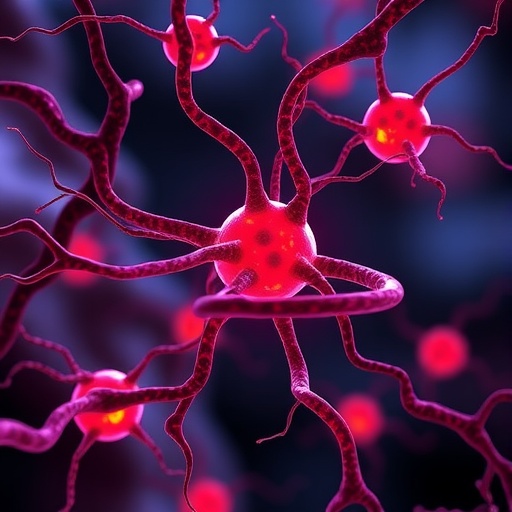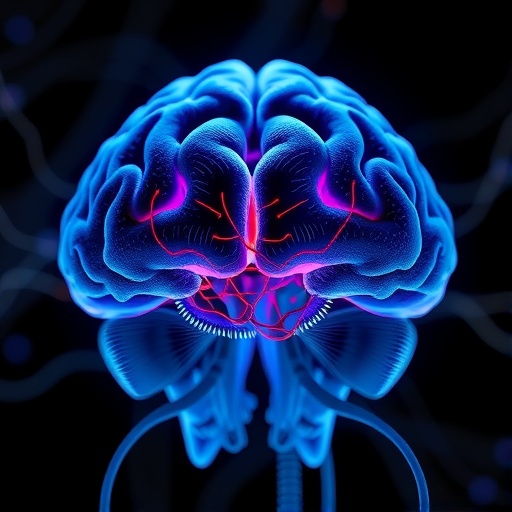
In a groundbreaking study poised to reshape our understanding of Parkinson’s disease at the cellular level, researchers have unveiled the nuanced ways in which dopamine and cortical neurons carrying various Parkinsonian mutations exhibit distinct patterns of lysosomal and mitochondrial dysfunction. This meticulous cellular exploration highlights the heterogeneity underlying neurodegeneration, stressing the need for mutation-specific therapeutic strategies against this devastating disorder that affects millions worldwide.
Parkinson’s disease (PD), characterized primarily by progressive motor dysfunction and a host of non-motor symptoms, has historically been understood through the lens of dopaminergic neuron loss in the substantia nigra. However, this new research peels back additional layers by examining not only dopamine neurons but also cortical neurons harboring mutations linked to familial and sporadic forms of the disease. Researchers employed cutting-edge cellular assays and genomic tools to reveal how distinct genetic mutations tied to Parkinsonism differentially impair lysosomal and mitochondrial pathways, two critical cellular mechanisms implicated in PD pathogenesis.
Mitochondria — often dubbed the powerhouses of the cell — are essential for energy production and cellular homeostasis. Dysfunction of these organelles in neurons has been increasingly implicated in Parkinson’s disease, given their role in reactive oxygen species generation and apoptosis regulation. This study reveals that depending on the nature of the Parkinsonian mutation, dopaminergic neurons and cortical neurons vary significantly in the degree and type of mitochondrial impairment they experience. Some mutations trigger severe disruption in mitochondrial membrane potential and reduced ATP production, while others lead to increased oxidative stress without substantial energy deficits, illustrating a complex mutation-specific mitochondrial dysfunction profile.
.adsslot_A2niNgk0DY{width:728px !important;height:90px !important;}
@media(max-width:1199px){ .adsslot_A2niNgk0DY{width:468px !important;height:60px !important;}
}
@media(max-width:767px){ .adsslot_A2niNgk0DY{width:320px !important;height:50px !important;}
}
ADVERTISEMENT
Equally critical are lysosomes, the cell’s degradation and recycling centers. Proper lysosomal function ensures the removal of damaged organelles and misfolded proteins, a process fundamental to neuronal survival. PD-linked mutations were found to differentially compromise lysosomal integrity and functionality, with some mutations causing marked impairment in lysosomal acidification and enzymatic activity, thereby stalling autophagic flux. This impairment not only exacerbates the accumulation of toxic protein aggregates, such as alpha-synuclein, but also amplifies mitochondrial damage through disrupted mitophagy, underscoring a vicious cycle contributing to neuronal demise.
Interestingly, the research establishes that cortical neurons, traditionally less emphasized in PD pathology compared to dopaminergic neurons, also display mutation-dependent vulnerabilities that could explain non-motor symptoms and cognitive decline observed in Parkinson’s patients. Variations in lysosomal and mitochondrial dysfunction within these cortical populations reveal a broader neurodegenerative landscape that interfaces with disease progression beyond the basal ganglia circuitry.
The researchers utilized induced pluripotent stem cell (iPSC) technology to generate patient-specific neuronal models carrying varied Parkinson’s mutations, including those in LRRK2, SNCA, PARK2 (parkin), and GBA1 genes. This sophisticated modeling allowed high-resolution analysis of organelle dynamics, autophagic flux, and bioenergetic assessments under controlled laboratory conditions. Employing live-cell imaging and fluorescent reporters, they meticulously documented how each mutation uniquely altered lysosome size, distribution, acidification, and mitochondrial network morphology, providing unprecedented insight into subcellular pathology.
A particularly novel aspect of this study is the delineation of how dopamine itself modulates these dysfunctions. Dopamine, while essential for normal motor function, is a neurotoxin in excess, susceptible to oxidative reactions creating reactive metabolites. The interaction between dopamine metabolism and organelle stress in mutated neurons unravelled complex feedback loops. For instance, some mutations rendered the neurons vulnerable to dopamine-induced lysosomal membrane permeabilization, leading to cytosolic release of lysosomal enzymes and subsequent cell damage — a pathological mechanism that could contribute to selective vulnerability seen in Parkinson’s disease.
Moreover, mitochondrial dysfunction patterns observed suggest potential stratifications for future drug targeting. For mutations causing mitochondrial depolarization, therapies aimed at stabilizing mitochondrial membranes or enhancing biogenesis might hold promise. In contrast, mutations chiefly affecting lysosomal function may benefit from agents that restore lysosomal acidification or boost autophagy. Such tailored intervention strategies highlight the precision medicine approach emerging from this research.
The findings also have implications for biomarker development. Identifying mutation-specific signatures of mitochondrial and lysosomal dysfunction in peripheral cells or biofluids could enable earlier and more accurate disease diagnosis, as well as monitoring of therapeutic efficacy. This is critical since current PD diagnostics largely rely on clinical symptomatology, which appears late in disease progression.
Beyond therapeutic and diagnostic applications, this study pushes the frontier of Parkinson’s disease genetics. It underscores the notion that not all Parkinsonian mutations are created equal regarding their downstream cellular effects. This phenotypic variability at the organelle level might explain the heterogeneity seen in clinical presentations and responses to therapies among patients, revealing why some manifest predominantly motor symptoms while others exhibit rapid cognitive decline or autonomic dysfunction.
In addition to the direct consequences of mitochondrial and lysosomal impairment, the work touches upon the intricate crosstalk between these two organelles. The autophagy-lysosome pathway is intimately connected to mitochondrial quality control through selective mitophagy. Disruption in either organelle’s function can propagate a domino effect, compounding cellular stress and triggering neurodegeneration. The careful quantification of such interplay across different mutations presents a platform to investigate synergistic therapeutic targets aimed at restoring organelle homeostasis holistically.
Importantly, the study’s comprehensive approach incorporating both dopaminergic and cortical neurons broadens the pathophysiological framework of Parkinson’s disease. While loss of dopamine neurons explains cardinal motor symptoms, cortical involvement likely underpins the cognitive and psychiatric manifestations increasingly recognized in PD. By demonstrating variable mitochondrial and lysosomal deficits in these neuronal types, the study supports the view that Parkinson’s is a multisystem disorder requiring multifaceted treatment paradigms.
The research team also points toward lifestyle and environmental factors potentially interacting with these genetic vulnerabilities. For instance, exposure to mitochondrial toxins or lysosomal stressors in the environment might exacerbate mutation-linked deficits, accelerating disease onset and progression. Understanding these gene-environment interactions can guide public health strategies alongside molecular therapeutics.
In summary, this seminal investigation published in npj Parkinsons Disease represents a major advance in deciphering the cellular underpinnings of Parkinson’s disease. By articulating how different Parkinsonian mutations drive distinct lysosomal and mitochondrial dysfunction patterns across neuronal types, it heralds a more nuanced era of PD research. This knowledge lays a vital foundation for developing precision diagnostics, personalized therapeutics, and ultimately improving outcomes for patients grappling with this complex neurodegenerative condition.
The study’s implications stretch beyond Parkinson’s, as lysosomal and mitochondrial dysfunction are core features of many neurodegenerative diseases. The methodologies and conceptual frameworks established herein may thus accelerate broader neuroscience research, opening pathways to combat conditions like Alzheimer’s, Huntington’s, and amyotrophic lateral sclerosis through targeted organelle biology approaches.
As the scientific community digests these findings, urgent questions arise about how to translate bench discoveries into clinical realities. Clinical trials designed around mutation-specific vulnerabilities, coupled with advanced biomarker technology, will be essential future steps. Moreover, integrating patient-derived neuronal models with in vivo studies will help validate potential therapies and refine understanding of disease mechanisms in the context of the whole brain.
Ultimately, this research marks a pivotal stride toward unraveling the intricate cellular choreography disrupted in Parkinson’s disease. It exemplifies how combining genetics, stem cell technology, and cutting-edge imaging can illuminate mysteries that have long hindered therapeutic progress, offering hope that one day, precision cures for Parkinson’s may be achievable.
Subject of Research: Dopaminergic and cortical neuron dysfunction related to lysosomal and mitochondrial pathways in Parkinson’s disease mutations
Article Title: Dopamine and cortical neurons with different Parkinsonian mutations show variation in lysosomal and mitochondrial dysfunction
Article References:
Chedid, J., Li, Y., Labrador-Garrido, A. et al. Dopamine and cortical neurons with different Parkinsonian mutations show variation in lysosomal and mitochondrial dysfunction. npj Parkinsons Dis. 11, 177 (2025). https://doi.org/10.1038/s41531-025-01048-2
Image Credits: AI Generated
Tags: apoptosis regulation in neurodegenerationcortical neurons and Parkinson’sdopamine neuron dysfunctionenergy production in neuronsfamilial Parkinson’s disease geneticslysosomal impairment in neuronsmitochondrial dysfunction in Parkinson’smutation-specific therapeutic strategiesneurodegeneration cellular mechanismsParkinson’s disease mutationsreactive oxygen species in Parkinson’ssporadic Parkinson’s disease research





